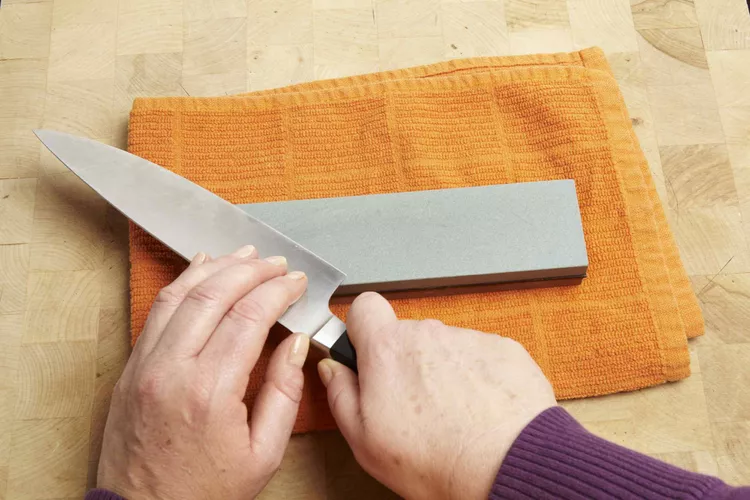Sharpening knives requires the appropriate angle. Many folks are uncertain about what angle to use and how to sharpen their knives. This post will discuss knife sharpening angles and offer expert advice. This detailed tutorial can help you sharpen knives, whether you’re a chef or a cook.
What Angle to Sharpen Knife: Exploring the Basics

Understanding knife sharpening angles is crucial. The angle is the blade’s sharpness. Your knife angle depends on its type, use, and personal choice. Let’s look at knife-sharpening angles.
Acute Angle (15-20 degrees): Extremely sharp knives are used for precision cutting. They chip or dull faster due to their smaller edges. Fillet, pocket, and Japanese kitchen knives have these angles.
Standard Angle (20-25 degrees): Most kitchen and utility knives use this angle. Sharpness and durability are balanced. This angle can slice meat and veggies.
Wide Angle (25-30 degrees): Heavy-duty knives with a broader angle offer a stronger edge. They can endure harder cutting and slicing. Hunting, survival, and some tactical knives feature larger sharpening angles.
Factors Influencing the Sharpening Angle

Several factors affect knife sharpening angle. Key considerations:
Knife Intended Use: The knife’s intended function determines the sharpening angle. Filleting fish or making complex cuts often require a lower, more acute angle (15-20 degrees).
However, knives used to chop bones or difficult materials may need a greater, broader angle (25-30 degrees) for longevity.
Knife Type and Design: Blade thickness, geometry, and bevel design vary by knife type. Japanese knives feature smaller blades and lower angles. Thicker European knives are honed at a steeper angle. When choosing a sharpening angle, examine the knife’s design.
Steel Hardness: Knife steel hardness impacts sharpening angle. Sharpening kitchen knives with softer steels is possible at lower angles. High-end and specialised knives use harder steels, which require steeper angles to prevent chipping.
User Skill and Preference: Sharpening skill and preference also matter. Some prefer a sharper edge for precision slicing, while others prefer a wider angle for longevity. Find the right balance for your skill level and cutting style.
Cutting Technique: Cutting technique affects sharpening angle. If you cut harder or chop, a wider angle may be better. Slicing or push-cutting with less pressure may require a lower angle.
Maintenance and Frequency: Maintenance and sharpening frequency affect the angle. Since you can readily sharpen the knife, you may choose a somewhat lower angle. If you sharpen occasionally, a slightly higher angle may prolong the edge.
Different Sharpening Angles for Various Knives

After discussing the elements affecting sharpening angles, let’s look at some recommended angles for different knives:
Chef Knife
A chef’s knife’s adaptable 15-20-degree angle makes it useful for many kitchen jobs. This angle is sharp and durable, making cutting easy.
Paring Knife
Peeling and trimming require sensitive paring knives. Sharpen paring knives at 10-15 degrees for best results. This sharper edge allows delicate cutting and control.
Sharp Knife
Serrated knives’ toothed edges require specific sharpening. Maintaining the serrated shape is important even when the serrations’ bevelled edge is sharpened like the chef’s knife. To sharpen each tooth, glide a tapered or rounded sharpening rod along the serrations.
Hunting/Outdoor Knife
Hunting and outdoor knives endure strong materials and use. Sharpen these knives at 20-25 degrees for durability. This angle is stronger for wilderness tasks.
Pocket Knife
Pocket knives are useful for regular jobs and outdoor activities. A pocket knife is usually sharpened at 15-20 degrees. This angle balances sharpness and longevity for a variety of cutting needs.
Japanese Knife
Japanese knives are sharp and delicate. To get their famously sharp edge, sharpen these knives at 10-15 degrees. Protect the knife’s delicate blade by using suitable technique.
Angle Sharpening FAQs
What makes a knife sharpening angle shallow or steep?
Sharpness versus durability is the key difference. A shallow angle sharpens yet weakens the edge. A steep slope makes an edge stronger but duller.
What is my knife’s edge angle?
Angle guides and sharpening jigs can measure and mimic the angle. Some knife makers prescribe angles.
Can all my knives have the same angle?
Most knives can use a general angle, but you need adjust it based on kind, purpose, and steel hardness. Adjusting the angle improves performance and longevity.
Multiple-angle sharpening methods?
Guided or adjustable angle sharpeners may handle different angles. These techniques make precise knife sharpening easy.
Can a knife be sharpened without tools?
Sharpening stones and honing rods help sharpen knives. To get good outcomes, you need excellent technique and consistency.
Sharpening knives: how often?
User choices determine sharpening frequency. Professional chefs sharpen their knives more often than home cooks.
Conclusion
Knowing what angle to sharpen a knife is essential for anyone who values efficiency and precision. Optimise cutting performance by knowing the elements affecting the sharpening angle and customising it to different knife kinds, uses, and personal preferences.
Use safe sharpening methods and tools. You’ll master knife sharpening with practise and patience.
